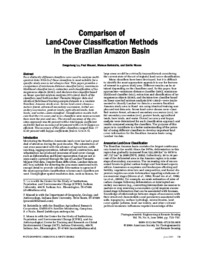Comparison of land-cover classification methods in the Brazilian Amazon Basin.
Comparison of land-cover classification methods in the Brazilian Amazon Basin.
Author(s): LU, D.; MAUSEL, P.; BATISTELLA, M.; MORAN, E.
Summary: Four distinctly different classifiers were used to analyze multispectral data. Which of these classifiers is most suitable for a specific study area is not always clear. This paper provides a comparison of minimum-distance classifier (MDC), maximumlikelihood classifier (MLC), extraction and classification of homogeneous objects (ECHO), and decision-tree classifier based on linear spectral mixture analysis (DTC-LSMA). Each of the classifiers used both Landsat Thematic Mapper data and identical field-based training sample datasets in a western Brazilian Amazon study area. Seven land-cover classes? mature forest, advanced secondary succession, initial secondary succession, pasture lands, agricultural lands, bare lands, and water?were classified. Classification results indicate that the DTC-LSMA and ECHO classifiers were more accurate than were the MDC and MLC. The overall accuracy of the DTCLSMA approach was 86 percent with a 0.82 kappa coefficient and ECHO had an accuracy of 83 percent with a 0.79 kappa coefficient. The accuracy of the other classifiers ranged from 77 to 80 percent with kappa coefficients from 0.72 to 0.75.
Publication year: 2004
Types of publication: Journal article
Unit: Embrapa Territorial
Observation
Some of Embrapa's publications are published as ePub files. To read them, use or download one of the following free software options to your computer or mobile device. Android: Google Play Books; IOS: iBooks; Windows and Linux: Calibre.
Access other publications
Access the Agricultural Research Database (BDPA) to consult Embrapa's full library collection and records.
Visit Embrapa Bookstore to purchase books and other publications sold by Embrapa.

